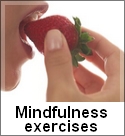By now you should have a good idea of what mindfulness is, but how do you incorporate mindfulness techniques into your everyday life and make it part of who you are?
Not all of us have the time, inclination or discipline to practice mindfulness for a few hours a day or to became a master at it, but we all can take a few moments here and there throughout our day to be mindful.
You will find these mindfulness steps will have an accumulative effect and you will notice the positive benefits…subtle at first that get stronger over time.
 Walk mindfully
Walk mindfully
Instead of walking without thinking, try focusing you attention on the sensations of your feet touching the ground, your breath as you walk and take note of what is around you.
As you put your foot down, pay attention to the different parts of your foot as it make contact with the ground. Listen to the sound of your steps. As always when you realise you are back caught up in thoughts just return your your focus without any judgement or criticism of yourself.
Take stock of yourself
Stop for a moment and notice how your body is feeling at this precise moment. How are you muscles feeling? How about your feet? Are you tense or relaxed? Are you breathing normally? Do you have a headache? Are you hungry or thirsty?
Just take note of how your body is feeling. You don’t need to attach meaning to it or try to find solutions. Just be aware of yourself in this moment.
Your environment
Stand or sit very still for a few moments and have a look at the world around you. Use all your senses to “look” around you.
• What do you see?
• Hear?
• Smell?
• Feel?
• Taste?
Mindfulness Quick Links:



Zone in
Focus your attention on an object close to you. Look at it very carefully, as if you are seeing it for the first time. Take note of its shape, colour, texture and the detail of the workmanship.
When you find you thoughts drifting away, gently re-focus on the object.
Mind your routine
All of us have a routine we follow. We put our shoes on in the same way every day, brush our teeth, splash our faces or sip our coffee or tea in the same way. Next time you do something from your daily routine, pay careful attention to your body movements, the sensations you are feeling, the sounds, smells and taste.
In other words remain focused on the everyday simple thing you are doing as opposed to the usual autopilot situation where you are doing things but your mind is caught up in other thoughts. Chose a routine to be mindful with. As it becomes easier add more of what you do in the day to this practice.
Label your thoughts
When you are sitting quietly and became aware of the thoughts going on in your head, label them. If you are thinking about what you should pick up from the shops, label that thought “shopping.”
When you feel an emotion label it “anger,” “resentment,” “worrying” or whatever is applicable for you at that moment.
Labelling your thoughts helps you to observe them objectively without becoming emotionally involved (reacting and feeding the thoughts and feelings) and/or becoming caught up in analysing them.
Labelling and observing your thoughts helps to keep you in the now moment, which rests your mind and emotions. With your mind more calm and quiet you will find that constructive solutions and the motivation to act will come naturally with less effort and better results.